Fashion is one of the many remarkable artistic domains in which no limitations are set, and designers are always stepping up their game to produce fashionable clothing articles that are also aesthetically appealing. Such an element of design that has been incorporated into clothing with a view of giving stylish character, liveliness and sophistication to garment is flounce. Flounces describe a type of garment component which has ruffled or even pleated fabric and the part can turn a plain dress into an eye-catching one. Here the conventionalism is shown by studying the different types of flounces that are in fashion, the history of their creation, and the methodology of their creation as well as the manner in which they can be combined with different garments to meet a diverse range of designs.
What is Flounces?
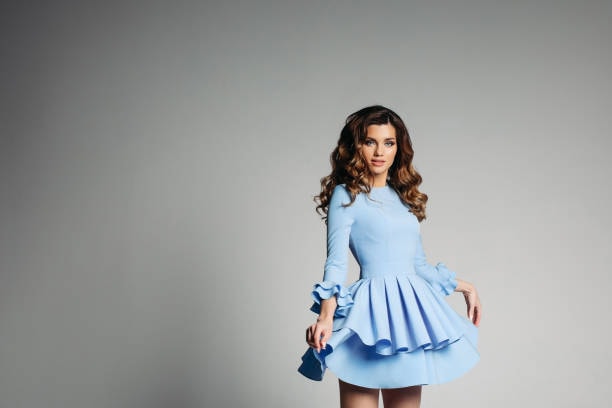
Flounces are forms of fabric accessories that produce ruffled or folded cutting in garments enhancing the base fabric with thickness and rhythmic motions. They are made of slicing pieces of fabric like half-circle, spiral or rectangle, and then they are stitched to the clothes and in the process they form waves or types of ruffles. A flounce is usually applied to skirts, sleeves and necklines, as this element adds romantic, elegant or even dramatic look to the model.
The History of Flounces

Flounces have been in existence since the 16th century though they originated in Europe. Flounces were considered fashionable especially in the age of Rococo during the middle of the eighteenth century and marked by the complexity of their ornaments. Blouses of women’s dresses had layers of flounces that gave the silhouette of the dress more volume and primer. proportions, and the impression of luxuriousness. It is noteworthy that, during the years, flounces are used in different epochs and they are a part of different motions of fashion, starting from Victorian dresses and up to nowadays.
Types of Flounces
Flounces can be made of any type of ruffle in different patterns, shapes, and dimensions; every flounce creates a special accent to the garment. Below, we delve into the different three types of ruffles flounces and how they can be used in fashion:
Circular Ruffle Flounce
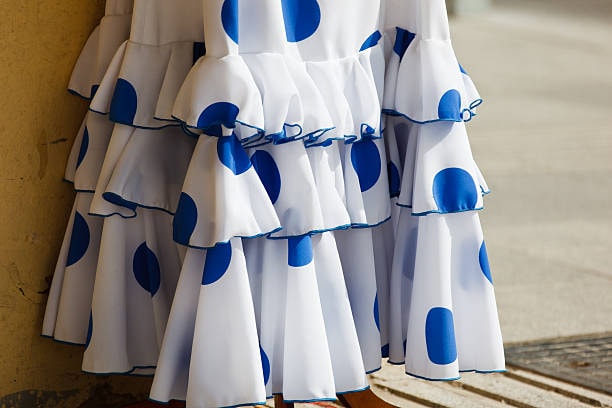
There is the double edged ruffle also referred to as the circular ruffle; this flounce is created by cutting a semicircle from the fabric with a cavity in the middle as well as outside circle. Regarding the appearance of each circle, it is stated that when this outer circle is united to a garment, it produces soft waves at the back. Apart from being incorporated as waist treatments, circular flounces can be applied on sleeves, skirts and necklines. Due to their loose construction, they lend themselves well to be worn with dresses and blouses in the hopes of acquiring that air of romance.
Spiral Flounce
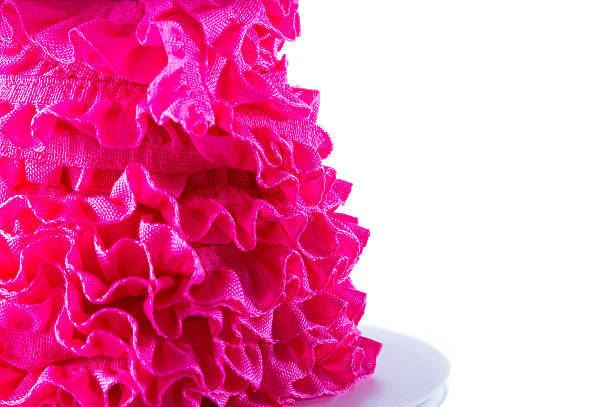
A spiral flounce is achieved by making one long spiral strip of the fabric. This type of flounce looks differently from a straight line or straight edge circular flounce, it seems to be more voluminous and to have more movement. It becomes even more so if double layer flounce is attached to it, the appearance of the garment becoming rich, luxurious and utterly distinctive. Spiral flounces are expected to be used mostly in evening wear dresses, and other upscale designs, to bring in the element of sophistication and romance into the garment.
Double-Layered Flounce
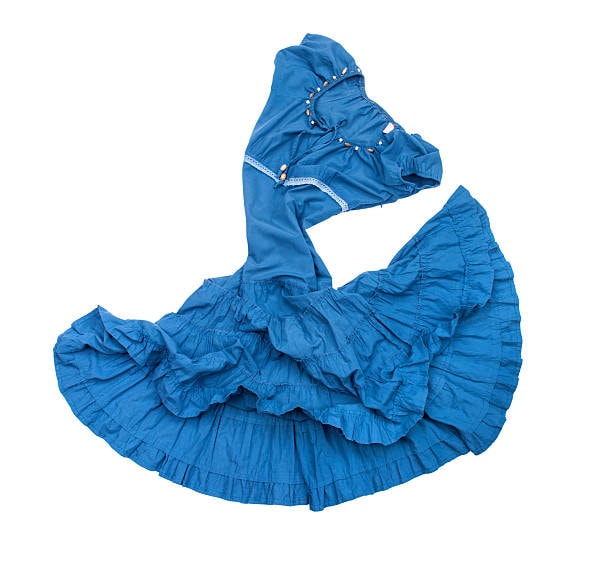
Double layer flounces are given by two layers of fabric, the one edge of which has the length of the other layer doubled. This type circular shape of flounce increases dresses’ form-creating feeling and makes it have more luxurious look. Flounces consisting of two rows are also applied to skirts and sleeves to provide touch of refinement and elaboration.
Asymmetrical Flounce

Flounces that are asymmetrical are made in a way that one side of the garment is longer than the other, making it sophisticated and punk. The flounce pattern of fabric gathered this type is quite suitable for modern clothing, especially since asymmetry is used to add some intricacy and the individuality of the double edged ruffles. Asymmetrical flounces can be used in skirts, dresses and tops although such application will give the conventional knife pleats a touch of the avant-garde.
Tiered Flounce

Overlapping flounces are preparations, which are created by laying one flounce over another and it can be tiered flounces. This pattern gives the clothing item a more fuller and complex look compared to other ruffle skirts, it is more of a statement piece. Many layered flounces are applied in trail dresses, celebration gowns, and ethnical costumes to provide a royal and magnificent hem allowance.
Pleated Flounce
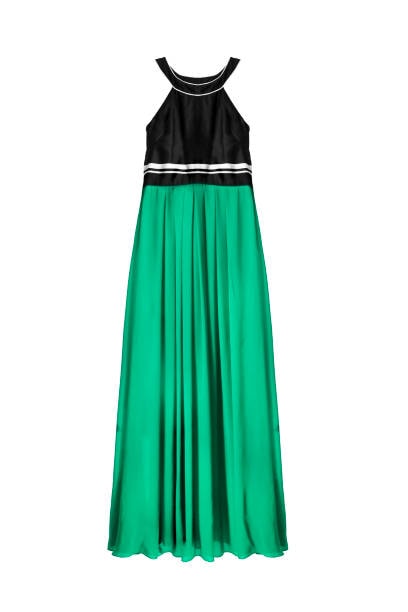
Self fabric flounces are made with the help of a band of fabric being embroidered and pleated before being sewed on the garment. This type of flounce is organized, very sophisticated, formal, and thus it is most appropriate to wear it in a formal event – pleated ruffle. Tentative folds can be applied to skirts, sleeves, collars, which will make the shirt more elegant and suitable for expensive and high-quality clothes.
Bias-Cut Flounce
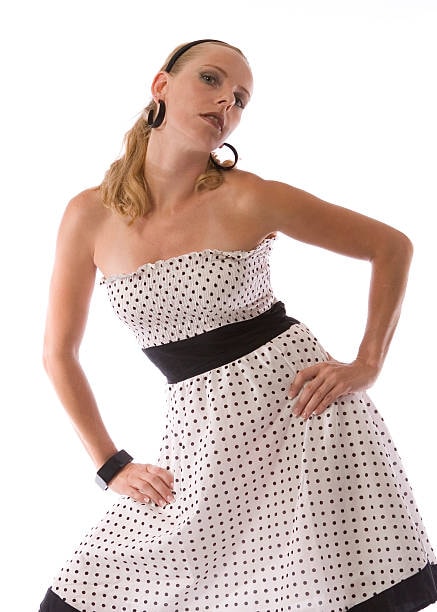
Bias-cut flounces are created by cutting the fabric on the bias, or on the edge of the cross grain which is a waterfall ruffles. This way raw edges of the fabric can drape and flutter wonderfully and makes awesome flounces thus making it soft and fluent. Bias-cut flounces are applied for skirts and dresses, in which they create an elegant and feminine motion.
Gathered Flounce

Accumulated flounces are created by ruffling the fabric one stitch at a line before joining it to the garment. This forms a ruffle and voluminous look and feel thus bringing a playful and the feminine aspect in as the design pattern stitched ruffles. Accumulated fabric is more frequently applied on skirts, blouses, and dresses where it forms flounces that are delightful and tender in their appearance.
Constructing Flounces
To make flounces, some amount of accuracy and focus is needed in constructing a cascading ruffle. Here are explained the procedures of construction of various kinds specific patterns of flounces:
Circular Flounce pattern
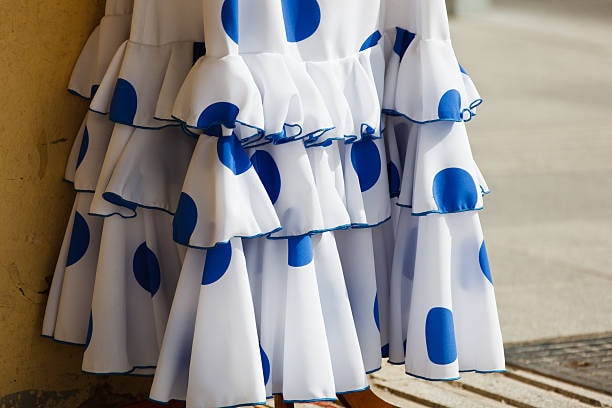
- Measure and Mark: When using this type of flounce, the key decision is the width and length that is to be achieved. Now, draw a circle on the fabric needed of the relevant measurements; the inner and outside edges are circular ruffles.
- Cut: In case you have a disc of fabric with a slit in the middle cut along the lines given to get a disc-shaped piece.
- Hem: Sew the rest of the edges of the fabric by putting some turns of hemming. This can be done by a narrow hem or by the rolled hem, if it corresponds to the particular model of clothing.
- Attach: Sew the flounce more specifically in the interior curve of the ruffle flounce’s hem. Make sure the flounce is positioned specifically in the right way to have an even look.
Spiral Flounce ruffles

- Measure and Mark: Find out how wide and how long the required flounce should be. Dip a fork in the fabric paint, and place on fabric start from the outer edge and move in and then out and so on till the center =spiral ruffle.
- Cut: Snip off on the lines drawn, to obtain a long strip of fabric in the form of a spiral.
- Hem: After that, it is necessary to complete the edges of the fabric and do it by making a hem. This can be done using a narrow hem or a rolled hem depending on the look that is wanted for the inside of the inner circle.
- Attach: Fasten the flounce to the garment using the sister technique, in which you sew along the inside of the spiral. Lastly, make sure that the flounce is evenly spread for good finishes to be achieved and you have a perfect flounce dress.
Double-Layered Flounce ruffles

- Measure and Mark: It is necessary to define the width and length of both of the flounce layer, which must be the desired width and length. Take markers and draw a bigger circle outside a smaller circle on the fabric of the garment.
- Cut: Visae, and divided along the dotted lines making two round pieces of fabric with an opening in the middle.
- Hem: Sew the edges of the fabric to cover them. This can be done with a narrow hem and or a rolled hem depending on the designer’s preference.
- Attach: Place the small circle on top of the big circle; then there and there fix the two to the part of the garment along the inner curve. Make sure that the flounces are evenly spaced to gain a smooth look of the flounces.
Asymmetrical Flounce
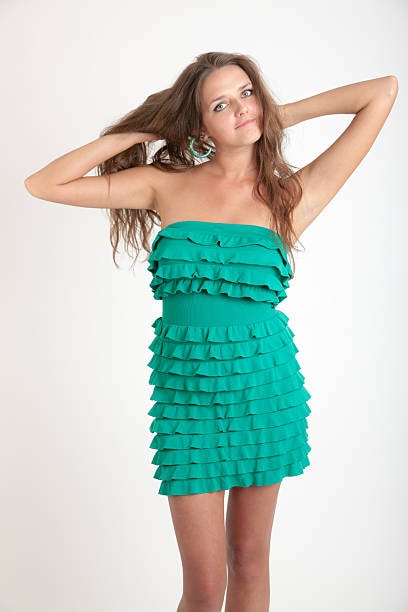
- Measure and Mark: Decide the length and width of the flounce, one side should be longer than the other side. Sketch a shape that is distorted on one side on the fabric.
- Cut: Fold the fabric along half length and cut along the fold; this makes the piece of fabric to be asymmetrical.
- Hem: Sew the remaining part of the fabric edges so as to have the fabric hemmed. This can be done making a narrow hem or a rolled hem, whichever you would like to achieve.
- Attach: Grow the flounce starting at the bottom edge of the garment because you will sew along the inner edge of the flounce. Make sure it is applied evenly so that there are no lumps as this will make the flounce look uneven.
Tiered Flounce
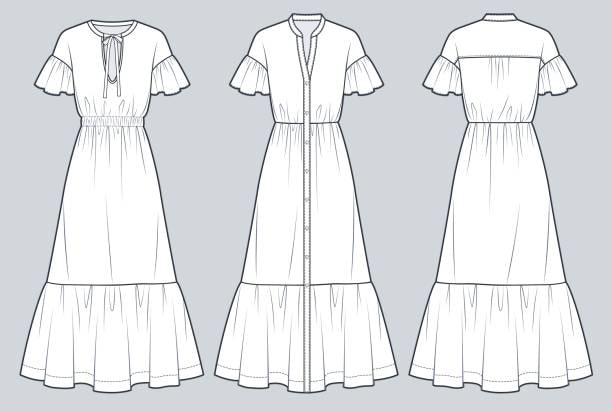
- Measure and Mark: Select for each tier the desired width and length that will help meet the store’s goals. Make several circles or spiral wings and place the circles one over the other to be larger than the one below it.
- Cut: Snip off along the marked lines, which would in so doing produce more pieces of fabric that will have different dimensions.
- Hem: Sew the edges of the fabric so that they should be clean and should not fray. This can be done with the use of a narrow hem or a rolled hem depending with the given design.
- Attach: Arrange them one on top of the other in a descending hierarchy that is, the largest one goes at the bottom and the smallest one goes on top. Sew the edges of each layer to the garment along the inner line that has been drawn. Make sure that the flounces are placed uniformly as this will give the clothes a smooth look.
Pleated Flounce ruffles
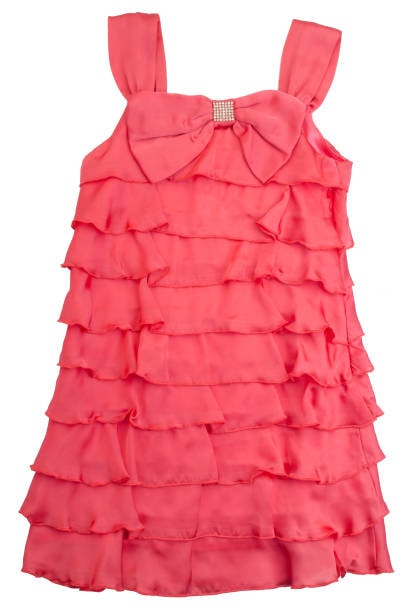
- Measure and Mark: Decide on how wide and how long you want your flounce to be. Domestically, draw a rectangle on the fabric.
- Cut: Make a cross cut along the seam allowance and along the length and width, obtain a rectangular piece of fabric.
- Pleat: Develop folds to the material by making some creases in a similar fashion. Pin or baste the pleats so they do not change or move while pressing.
- Hem: Sew the edges of the fabric giving it a hem. It is recommended to make it using a narrow hem or using rolled hem, based on the found preference.
- Attach: Sew the pleated flounce onto the material by sewing on the top side of the pleats. This should be done to make sure that the pleats are properly spread out on the garment to make it look sleek.
Gathered Flounce ruffles
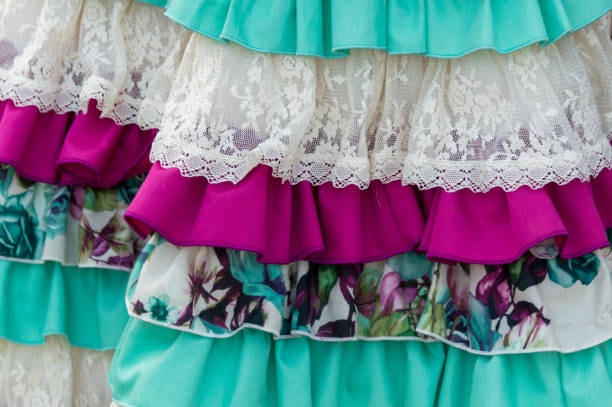
- Measure and Mark: Its necessary to establish what size of flounce is needed in width and in length. Place the fabric on the flat surface and using a pencil and ruler, make a rectangle on it.
- Cut: Along these lines make cuts on the fabric and you will be left with a rectangular shape fabric.
- Gather: Form structuring along one side of the fabric by sewing and pulling the fabric with basting stitch.
- Hem: Sew the edges of the fabric to complete the work done on them. This can be done using a narrow or a rolled hems depending with the intended appearance of the final product.
- Attach: ensure that all the flounce is gathered and sew along that gathered line then attach it to the garment. Make sure the gathers are spread out to finish off the attachment.
Incorporating Flounces in Fashion
It is also worth stressing that flounces can be used in various garments, in order to create different images or add a unique appearance. In the following sections, we focus on how flounces can be implemented to the different kinds of garments to tight and beautify them.
Dresses
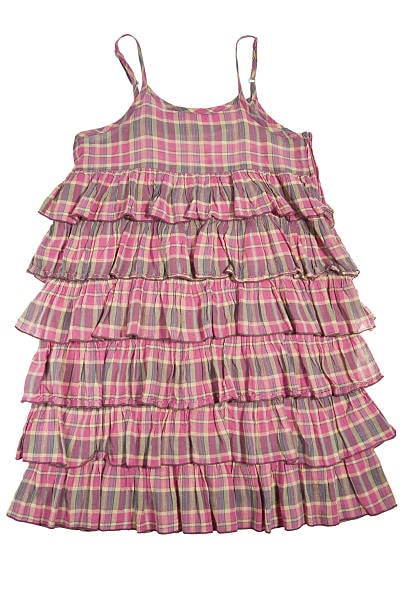
Flounces can turn any plain dress into the dress of the event or of the evening. Speaking of flounces as fabric trims, whether cascading flounce on the skirt, layered flounce at the sleeves, or flirty flounce at the hemline, all those are wonderful because they are beautiful and they move folded ruffle. Accordingly, flounces in evening gowns and formal dresses give the dresses a certain dramatic look as well as the sophisticated look, while in casual dresses it gives them a fun and girlish look.
Skirts
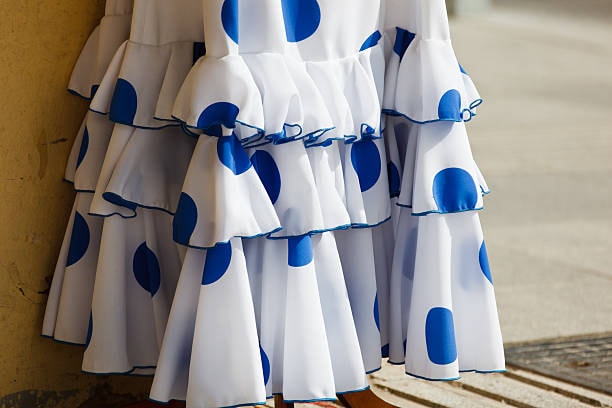
Flounces are used mostly in skirts for creating an attractive additional volume. Flounces can have simple one layer hem and can be multiple layers at the same skirt of the garment. Flounced skirts are relatively flexible, and they can be worn depending with the frequency of the occasion or even the party ruffle skirt. The pants are best worn with a fitted blouse or a t-shirt to avoid over powering the upper half circles the body as the bottom is really big.
Blouses and Tops
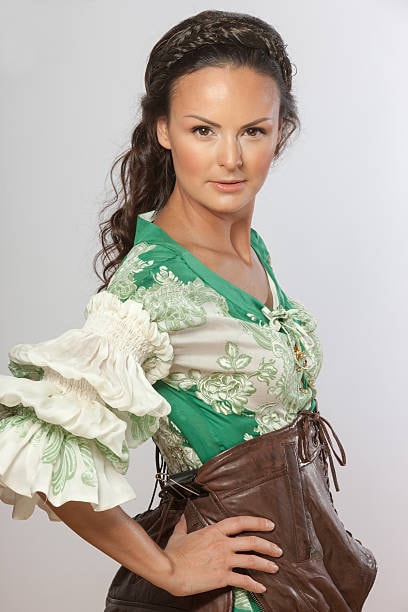
Thus flounces can be effectively applied to blouses and tops so as to make the clothes look elegant and attractive. It spikes up a simple blouse into an elegant piece of clothing and if incorporated into the sleeve or collar line of a t-shirt it gives it the class it deserves. Flounces on blouses and tops are universal to wear at work as well as during evening wear, which also covers the aspect of versatility.
Jackets and Coats

Flounces can be successfully used in the design of jackets and coats creating an element of surprise. Additional frills are possible on a collar or a lower hem and can turn the clothing into a high fashion piece. flounces located on jackets and coats may be useful, as well as the purely ornamental – the addition of insulation and a design element. They are used mostly to create tender and romantic look of clothes, especially outerwear for a woman.
Accessories
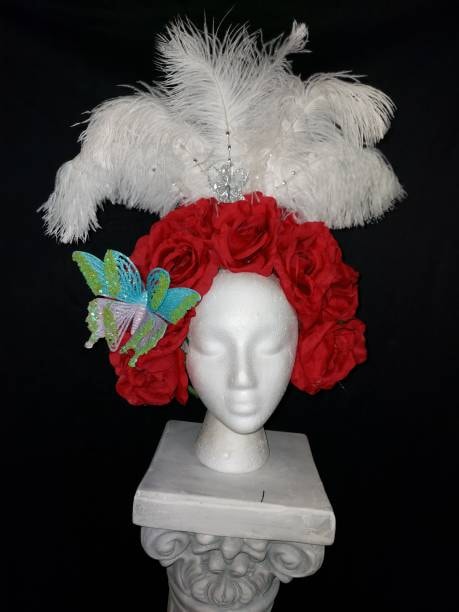
Perhaps, flounces are not only used in clothing but can be integrated into accessories as well to add flair and make them more classy. Scarves, floppy hats, and handbags that are flounced can add beauty accessories to any outfit. These interesting flounce accessories can be used to match flounced clothes or to put on a stylish flair to a less fancy outfit.
Styling Tips for Flounces
Flounced garments especially the skirts need to be balanced in some way so that when styled they look great. Here are some tips for incorporating flounces into your wardrobe:
Balance the Volume
Flounces provide width to clothing so care must be taken to prevent the ensemble from resembling a balloon, flounced garments thus ought to be worn with far more fitted accessories. For instance, what should be done is to pair a flounced skirt with a fitted top, or a flounced blouse with slim-fit pants to make the silhouette congruent.
Choose the Right Fabric
One can come to the conclusion that the choice of fabric has a direct influence on flounce’s appearance. Chiffon and silk give flounces airy and delicate look, whereas thicker materials such as wool or denim will give more rigid flounce. Select the fabric depending on the impact you want, as well as the event you want to use the clothes for.
Consider the Placement
The position of flounces influences the appearance of the attire. Flounces are absolutely plain if they are placed at the hemline or at the sleeves of the dress while flounces are more elaborate if they are placed at the neckline or line or at the bodice of the dress. There is one more step which has to be taken into consideration, concerning the placement of flounces to create the appropriate style.
Keep it Simple
Although flounced ladies garments are attractive, other parts of the dress and skirt and accessories should be relatively plain so as not to overwhelm the flounce double edge ruffle. This means letting the flounces exude as the attention and going for the simple accessories to blend with the dress.
Play with Proportions
Try out wearing some flounces of varying size to determine which looks the best ones for you. Greater and longer flounces are much more aggressive while less ones will look more tender.
Conclusion
Flounces are considered an All-Time hit and an elegant feature in vibrant clothing designs, which lends a certain pizzazz to garments and outfits. HIStory of flounces From the times when flounces appeared on models of dresses till these days they attract designers and avid lovers of fashion all over the world. When incorporated into dresses, skirts, blouses, or accessories being incorporated in garments, flounces are versatile and can thus be used to design excellent and fashionable garments. Thus, knowing the kinds of flounces, as well as ways on how to make and wear them, one will eventually be able to add this exquisite element to the outfit repertoire and appreciate the sophistication it adds to fashion.





